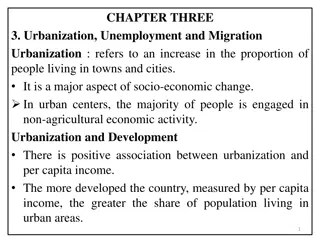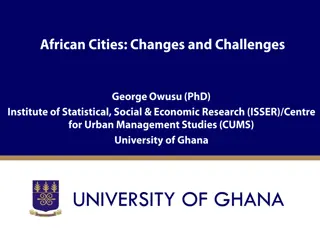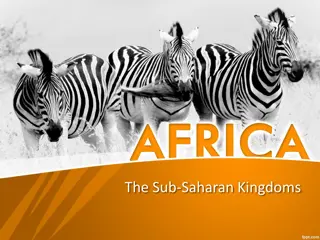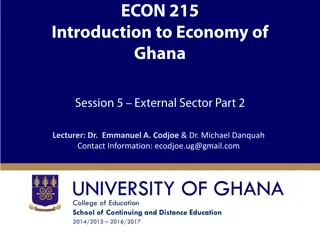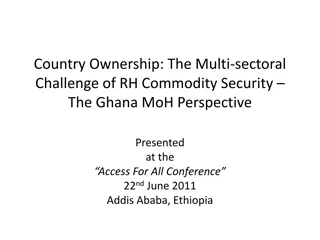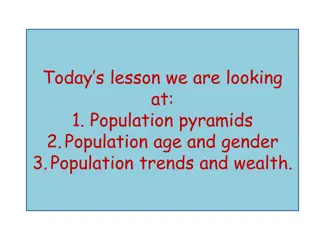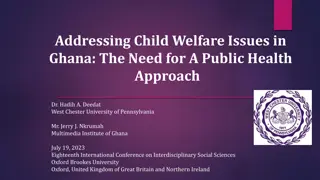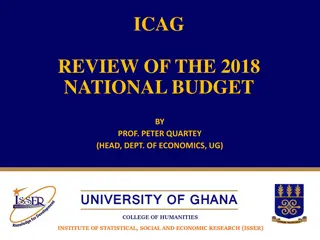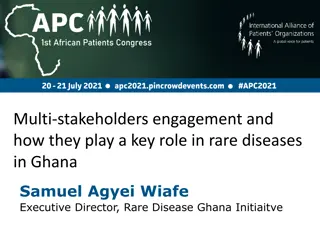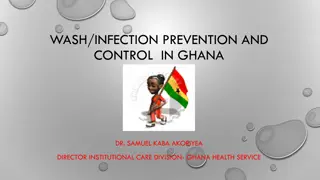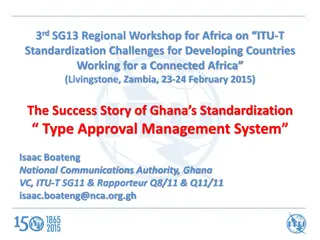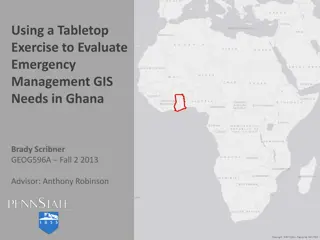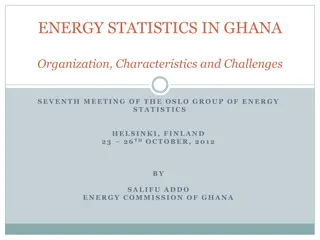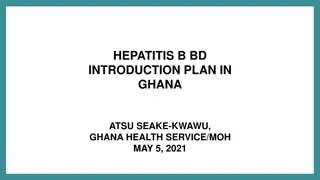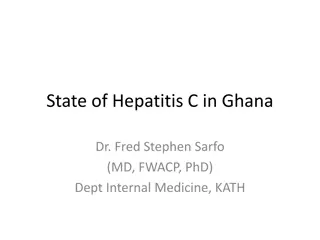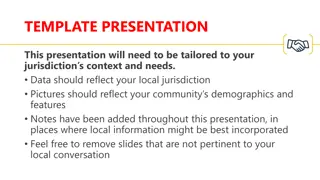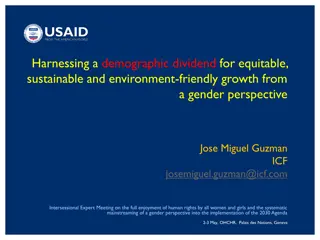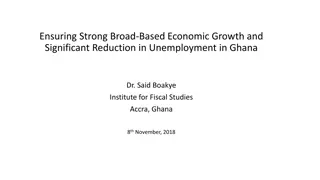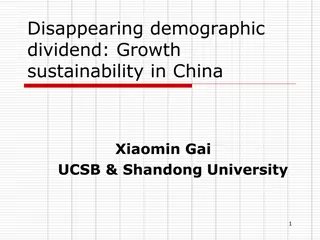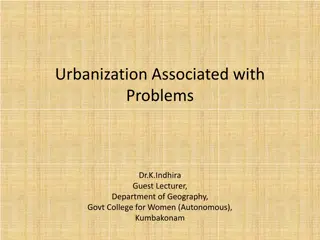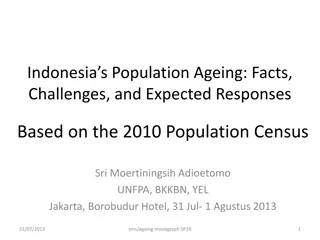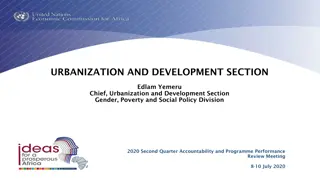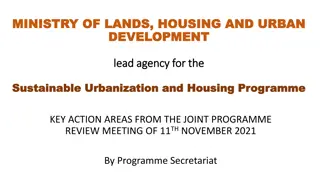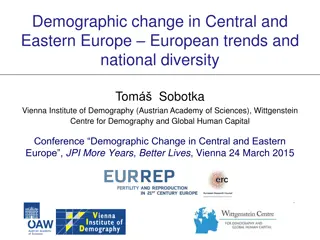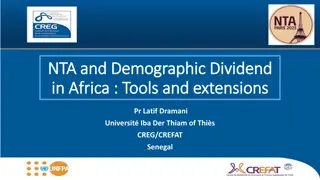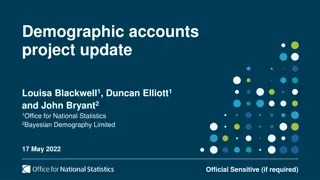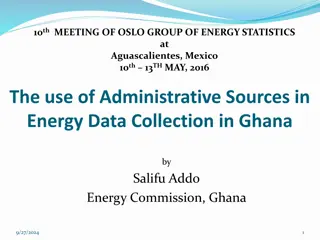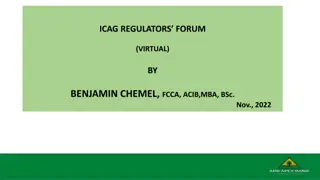Urbanization Trends in Ghana: Demographic Shift and Development Challenges
Ghana has experienced significant urbanization, with about 57% of the population urbanized in 2019. However, urban growth rates vary across Sub-Saharan Africa, with some countries showing counter-urbanization trends. In Ghana, urbanization has led to the concentration of population in major cities, creating challenges such as poor infrastructure, environmental issues, and socio-economic problems. Despite the overall urbanization trend, some regions in Ghana still show slow or stagnating urban growth rates.
Download Presentation

Please find below an Image/Link to download the presentation.
The content on the website is provided AS IS for your information and personal use only. It may not be sold, licensed, or shared on other websites without obtaining consent from the author. Download presentation by click this link. If you encounter any issues during the download, it is possible that the publisher has removed the file from their server.
E N D
Presentation Transcript
Introduction Introduction Ghana: Location and Politico-administrative Regions Estimated total population of 30.4 million (2019), with about 57% estimated to be urbanized and about (annual growth rate of about 3.7% (GSS 2019; World Bank 2015) Rapid urbanization characterized by skewed distribution of urban population, preference for large cities and towns. Main cities: Accra and Kumasi (million plus cities), Sekondi-Takoradi (4); Tamale and Tema. Regional disparities in level of urbanization: north-south divide reflecting level of development
The notion of rapid urbanization occurring in Africa has been questioned in recent years (Potts, 2009, 2012). urban growth rates in many Sub-Saharan African countries have slowed and recent censuses show that most city growth rates are around or below the national rates.
Introduction The demographic shift of population from rural to urban (urbanization) is slow or stagnating in most sub-Saharan African countries with varying experiences across countries: some demonstrating counter-urbanization (e.g., Zambia, Cote d Ivoire and Mali) some having weak city in-migration (e.g., Ghana, Benin and Mozambique) few countries have experienced high net in-migration (e.g., Tanzania, Kenya and Niger) Is this really the case, and are Ghanaian cities experiencing weak city in- migration?
Urbanization in Ghana Since formal census was introduced, Ghana s level of urbanization has been on the increase: from 7.8 (1921), 23.1% (1960) to 57% in 2018. However, few centres dominate this urban concentration (GSS 2013). Urbanization in Ghana represents a major redistribution of the population with preference for the very large cities and metropolitan areas. The recency and speed of the process have significant impact on development: Ghanaian cities lack required facilities and infrastructure. Cities are plagued by environmental problems (mainly poor sanitation/sewage, high levels of pollution); socio-economic challenges (unemployment, crime, violence, poor/inadequate housing, poverty, etc)
Ghana: Urbanization Trends and Projections, 1921-2060 100% 90% 80% 70% 60% Percentages 50% 40% 30% 20% 10% 0% 1921 1931 1948 1960 1970 1984 2000 2010 2020 2030 2040 2050 2060 Rural 92.2 90.6 97.1 76.9 71.1 68 56.2 49.1 42.8 37.4 33.2 29.5 25.5 Urban 7.8 9.4 12.9 23.1 28.9 32 43.8 50.9 57.2 62.6 66.8 70.5 74.5 Source: Derived from MLGRD/GoG, 2010; GSS, 2013; UNDESA, 2014 (NDPC, 2016)
Proportion urban and annual growth rate by Region 1960-2010 Urban Proportion Growth rate 1970/ 1984 3.3 1.7 1.7 3.5 3.5 2.9 3.1 4.6 Region 1960/ 1970 1984/ 2000 2000/ 2010 1960 23.1 24.7 28.0 72.6 13.1 21.1 25.0 15.6 1970 28.9 26.9 29.1 85.3 16.0 24.6 29.7 22.1 1984 32.0 22.6 28.8 83.0 20.5 27.7 32.5 26.6 2000 43.8 36.3 37.5 87.7 27.0 34.6 51.3 37.4 2010 50.9 42.4 42.1 90.5 33.7 43.4 60.6 44.5 All Regions Western Central Gt. Accra Volta Eastern Ashanti Brong- Ahafo Northern Upper East Upper West Source: GSS (2012, 2013) 4.7 2.9 2.1 6.1 3.9 3.4 4.6 6.1 4.6 6.1 3.7 4.8 3.6 2.8 6.3 4.7 4.2 3.7 3.2 4.4 3.9 3.3 4.7 4.8 13.0 3.9 5.0 20.4 7.3 6.7 25.2 12.9 10.9 26.6 15.7 17.5 30.5 21.0 16.5 7.6 7.8 4.0 4.9 6.5 5.7 3.1 2.3 4.7 4.8 5.0 4.2
Growth of Metropolitan Centres, 1970-2010 1970 1984 2000 2010 Pop % of Total Urban Pop % of Total Urban Pop % of Total Urban Pop % of Total Urban Metropolis Cape Coast 56,601 2.3 65,763 1.7 82291 1.0 183727 1.5 Tema Sekondi-Takoradi Tamale Kumasi Accra Total 60,767 143,982 83,623 46,336 624,091 1,015,400 2.5 5.8 3.4 14.0 25.2 53.2 1000,53 188,203 135,952 496,628 969,195 1,855,741 2.5 4.8 0.4 12.6 1,170,270 24.6 1,658,937 46.6 3,544,887 141,479 289,593 202,317 1.7 3.5 2.4 14.1 2,035,064 20.0 1,848,614 42.7 5,400,941 402,637 559,548 371,351 3.2 4.5 3.0 16.2 14.7 43.1 Total Urban Pop. (National) 2,472,456 3,934,796 8,274,270 12,545,229 Source: Derived from GSS 2002, 2013 (Owusu & Oteng-Ababio, 2015)
Fragmentation of metropolitan centres The last two decades have witnessed the proliferation of local governments (LGs) in Ghana: large cities and metropolitan centres have been affected most. Legal basis for the creation of LG areas or the alteration of boundaries is provided in Ghana s Constitution and the Local Government Act (Act 462), 1993. Act 462 empowers the President of Ghana to create municipalities/districts based on the recommendations of the independent Electoral Commission based on: Minimum population threshold; Geographic congruity, in terms land area, and social and cultural harmony and; Economic viability of area
Legal and Constitutional Basis for Creation of Local Government Areas Proliferation of Local Governments Number of Local Governments Metropolitan 3 4 6 6 6 Year 1988 2004 2008 2012 2018-2019 Municipal District 107 124 124 161 149 Total 110 138 170 216 260 Increase - - 10 40 49 105 +28 +32 +46 +44 Number of Electoral Constituencies and MMDAs, 1993-2019 Period 1993-2000 2001-2003 2004-2007 2008-2011 2012-2017 2018-2019 No. of Constituencies 200 230 230 230 275 275 No. of MMDAs 110 110 138 170 216 260
Urban Growth and Fragmentation of Metropolitan Areas: Case Study of the Greater Accra Metropolitan Area (GAMA) Population of GAMA, 1970-2010 1970 1984 2000 2010 District Pop. Growth Pop. Growth Rate Pop. Growth Rate Pop. Rate Accra Metropolis 636,667 3.0 969,195 3.3 1,658,937 1.1 1,848,614 Tema Metropolis 102,431 4.4 190,917 2.8 298,432 3.0 402,637 Other Municipalities Total 88,885 5.2 183,704 8.4 700,780 6.9 1,405,172 827,983 3.5 1,343,816 3.9 2,501,196 3.8 3,656,423
Fig. 1a: MMDA Areas in GAMA, 1988-2003 Fig. 1b: MMDAs in GAMA, 2004-2007
Map of Local Government Areas in GAMA, 2012-2015* *Boundaries of MMAs on this map do not represent the yet to be gazetted boundaries in GAMA
Municipalities/Local Governments within GAMA, 2018-2019 Name of Assembly 1. Ablekuma North Municipal Capital Darkuman Name of Assembly 14. Ga East Municipal Capital Abokobi 2. Ablekuma West Municipal Dansoman 15. Ga West Municipal Amasaman 3. Ablekuma Central Municipal Lartebiokorshie 16. Koley Klotey Municipal Osu 4. Accra Metropolitan Accra 17. Kpone Katamanso Municipal Kpone 5. Adentan Municipal 6. Ashaiman Municipal 7. Ayawaso East Municipal Adenta Ashaiman Nima 18. Krowor Municipal 19. La Dade-KotoponMunicipal 20. La Nkwantanang Madina Mun. Madina Nungua La 8. Ayawaso North Municipal Accra New Town Dzorwulu 21. Ledzokuku Municipal Teshie 9. Ayawaso West Municipal 22. Okaikwei North Municipal Tesano 10. Ayawaso Central Municipal Kokomlemle 23. Tema West Municipal Tema Community 18 11. Ga North Municipal 12. Ga South Municipal Ofankor Ngleshie- Amanfro Sowutuom 24. Tema Metropolitan 25. Weija-Gbawe Municipal Tema Weija 13. Ga Central Municipal Source: Ministry of Local Government & Rural Development, Accra, 2019 (Red indicates LGs which were part of Accra Metro Assembly in 2010)
Conclusion Restructuring of LG areas in many countries has broadly focused on the enlargement of the scope and reduction in the number of local governments (Meligrana 2005). This is, however, contrary to the Ghanaian case, where restructuring of local governments within the context of urbanization and globalization has largely involved the fragmentation and creation of new districts in metropolitan regions like GAMA. Beyond the challenges of fragmentation of large cities/metropolitan areas through the creation of LGs census data give the impressions of Ghanaian cities experiencing weak in-city migration.


